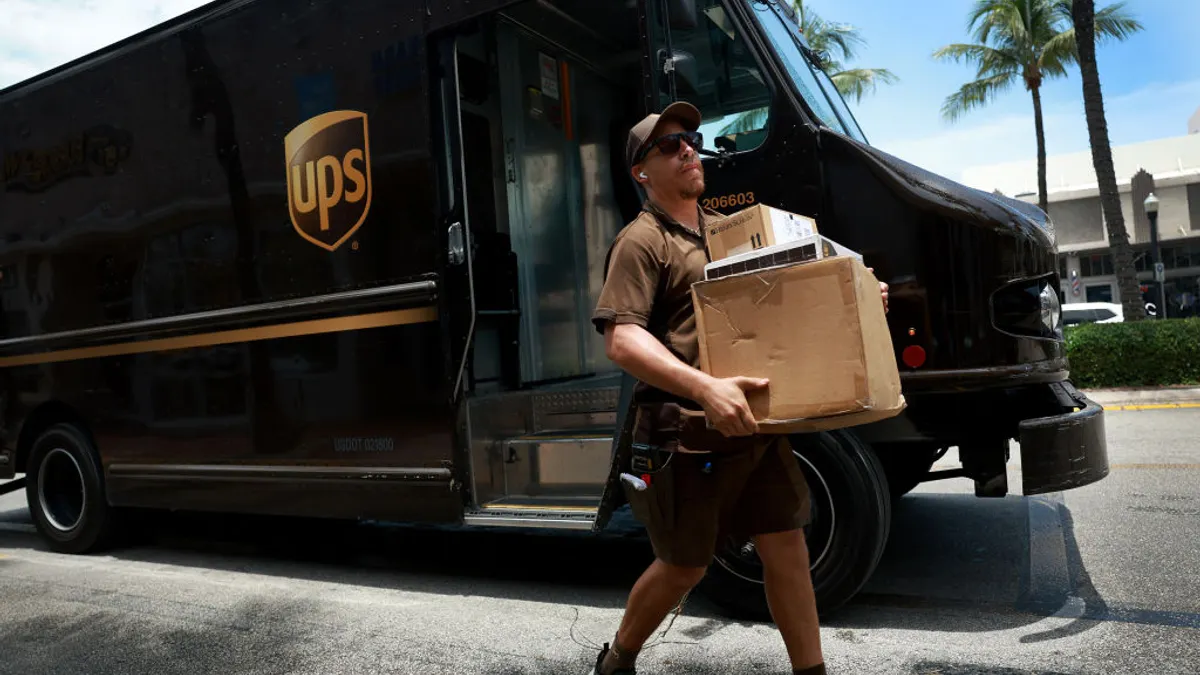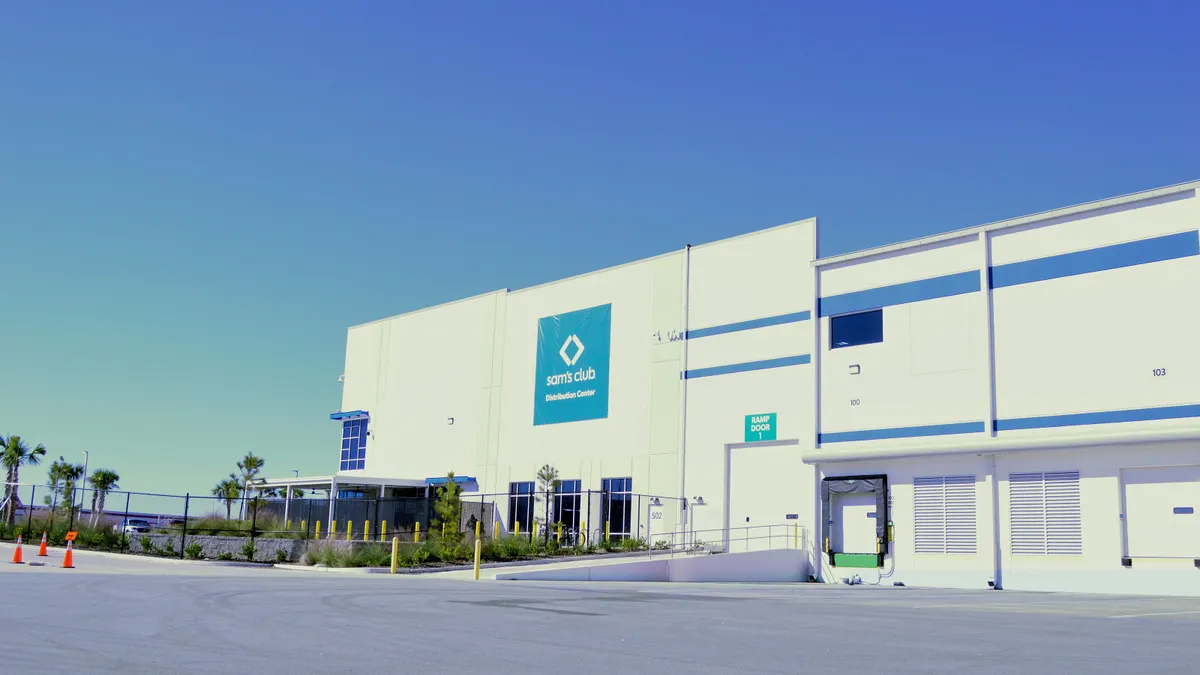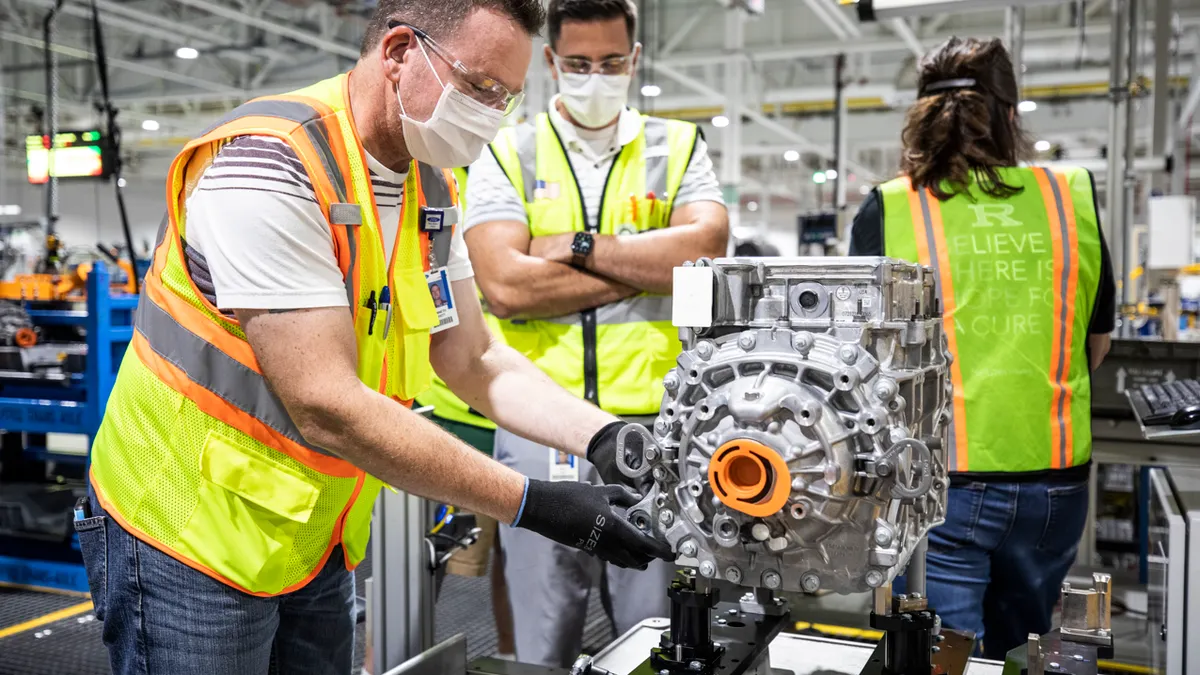It’s a good time to be an employee on the front lines of a large food manufacturing company.
Unemployment is at a 17-year low and demand for food processing is increasing. An additional 4.6 million manufacturing jobs will be added to the rolls during the next decade, according to a 2018 study by Deloitte and the Manufacturing Institute. While this is good news for employees, it's created challenges for food companies looking for workers — a problem that's only going to worsen in the coming years.
"They can't find the younger people who want to come in and be that spot welder or whatever that job is," Howard Dorman, a partner and practice leader in the Food and Beverage group at Mazars, told Food Dive. "It’s like all of the sudden, a whole generation of skilled workers who work on a line … we don't know what happened to them."
America’s unemployment rate currently sits at 3.7%, the lowest in 10 years, according to the U.S. Bureau of Labor Statistics. In the food manufacturing sector, that figure is slightly higher at 4.5%.
Although it would be easy to attribute this low unemployment rate to the rash of mergers and acquisitions, which makes it seem like the need for workers is shrinking, growing production and more demand for manufactured goods has resulted in a perpetual shortage of skilled workers to fill the positions.
"I know that manufacturing is still thriving ... but finding people is very difficult. It’s skilled labor," Dorman said.
But it is not just skilled labor that is suffering. Dorman said even finding people to drive distribution trucks or fill more senior ranks such as site and test managers is becoming difficult, too.
Andi Thornbury, a site manager of industry job board CareersInFood, said in an email that the site has seen a 12% increase this year in open roles posted in the food processing industry, and a 37% increase during the last 24 months. One of the most significant growth areas is in manufacturing, which she said showed a 51% increase in job openings. Additionally, she noted the number of customer service and packaging openings has more than doubled.
So where are all of the workers?
The answer to this question may lie in the combination of a changed set of expectations from workers and an altered list of benefits from companies.
Traditionally, manufacturing employees worked at a plant for years and took the stable pay, health care and secure retirement for granted.
While today’s workers are no less amenable to receiving these benefits, they have a different perspective that aligns with the 21st-century market. According to Will Eadie, global vice president of strategy at WorkJam, an employee engagement application used by manufacturers, this perspective includes wanting to work for companies with a strong, integrative culture, extra benefits like training and ongoing education initiatives.
Eadie told Food Dive these requirements pose challenges for companies as they try to orient themselves to attract qualified candidates from a limited pool of workers.
"How do they make them — the company themselves — more attractive to those people to bring them on?" he asked.
Part of the solution, he suggested, is through transparency and — much like on the consumer side — "showing (the company’s) shift workers how they’re sourcing from fair trade, they’re not using child labor, they’re using safe workplaces."
“Food companies are really starved for growth, so they have had to cut costs to the point that that is the only way to make money."

Tom Hayes
Former CEO, Tyson Foods
Once a company is able to communicate these intangible but desired components of a business to employees, it has a better chance of turning them into brand advocates, which will attract more workers, Eadie said.
"Who better to help you grow your talent network than your own employees?" he asked.
An ideal workplace is not an easy thing to find in any industry. In food manufacturing, employers find themselves squeezed as companies pursue cost-slashing initiatives intended to boost the bottom line and appease shareholders.
"Food companies are really starved for growth, so they have had to cut costs to the point that that is the only way to make money," Tyson Foods’ then-CEO Tom Hayes told Food Dive last year.
One result of this cost-cutting approach is a reduction in pensions and retirement benefits, which is causing employees to work longer.
Eadie argued this phenomenon is partially attributable to the positive development of safer workplaces that reduce injuries, and in the long run allow employees to work longer.
However, Dorman pointed to the economic reality of diminishing pension and 401k plans that force employees to hold jobs longer in order to bridge the gap between retirement needs and financial resources. According to the 2015 Employment Benefit Research Institute Confidence Survey, the percentage of workers aged 25 and over who planned on working past 65 has increased steadily from 11% in 1991 to 36% in 2015.
Although this approach of laboring longer works now for both employees and companies, there comes a point when people must retire. Dorman said there is no defined retirement age but "sometimes what happens is that (an) individual has been working for the company for so long he might be highly overpaid so companies will go in and come up with a little severance package for him."
Over time, this pattern will result in a gulf in the workforce, which will push jobs to other plants. Sometimes those plants will be owned by the same manufacturer.
"We’re seeing more and more manufacturers actually outsourcing their products (to those who have labor)," explained Dorman. He noted when this happens, plants can close, causing companies to suffer and forcing employees to relocate or learn new skillsets in order to find jobs.
Not only are companies struggling to attract new recruits — Eadie said it is more a question of finding quality, skilled recruits rather than just an applicant to fill a position — but current frontline workers are not necessarily progressing through the ranks to work in the less physically strenuous environment of management. According to CareersInFood, there has been a steady increase in demand for upper level and management positions during the last two years, demonstrating the gaping need for experienced professionals to help steer the industry.
When available, "you see people (who have the experience and skills) move up to a line manager or a test manager…You also see people move from the shop floor into the corporate," Eadie said. "I think manufacturers are getting really smart to realize that someone who has worked the line for 10 years probably knows something about those best practices and how to inject that into the complete supply chain or a complete assembly line."
The problem, he reiterated, is finding those people that will stay with a company for the long haul.
A unified front for improved wages
The industry finds itself in a bind. Without enough incentives — such as involved corporate culture, ongoing educational opportunities, continuous training and viable retirement plans — to attract workers to entry-level jobs in food manufacturing, companies are experiencing a shrinking pool of talent from which to pull their future leaders.
Still, companies can find hope in the economic reality that they need people and those people need jobs. The question is just how will those jobs provide what employees need in order to convince them to apply and stick around?
In the last century, unions have traditionally stepped up to the plate to negotiate a better environment for workers. They are still providing that service today. A Pew poll released this year found that the majority of Americans support unions, including an overwhelming 68% of those aged 18 to 29.
Kara Deniz, the senior communications coordinator for the Teamsters Union, said Teamsters’ data supported Pew's findings. "We have more than 50,000 members in the food processing industry," she said. If the dairy industry is included in these numbers, the union represents 80,000 individuals.
“Manufacturers are getting really smart to realize that someone who has worked the line for 10 years probably knows something about those best practices and how to inject that into the complete supply chain or a complete assembly line.”

Will Eadie
Global vice president of strategy, WorkJam
Although she anticipates membership numbers will rise, a minority of food manufacturing employees are union members. According to BLS data, the union membership rate was 10.7% in 2017, down from its highest level of 12.3% in 2008. Dorman explained the reason for this dwindling membership are better corporate benefits.
"They all pay above market, they get really good benefits, they get treated really well," Dorman said of his clients. "I’m not saying the unions are a bad thing, but it’s got to be for the right reason because as soon as the union gets involved, things change and it gets very expensive."
The decline in unions also has to do with post-recession legislation from governors around the country — including in Michigan and Indiana, which instated right-to-work laws. Wisconsin Gov. Scott Walker controversially signed a law to limit collective bargaining in the state in 2011. In Wisconsin, there are hundreds of food manufacturers including Cargill, Kountry Pride Farms and Archer Daniels Midland.
In Indiana, there is a long history of food manufacturing with companies such as Clabber Girl and Red Gold tomato products calling the state home.
Although these companies are still there, other food manufacturers have recently shut their doors. Last year, Manitowoc Food Service closed in Sellersburg, Indiana and moved its manufacturing to plants in Tijuana and Monterrey, Mexico. Similarly, Pretium Packaging closed its plant in Indiana, while 16 other plants remain open in the U.S. — mainly along the East Coast where unions remain strong.
“I’m not saying the unions are a bad thing, but it’s got to be for the right reason because as soon as the union gets involved, things change and it gets very expensive.”

Howard Dorman
Partner and practice leader, Food and Beverage group at Mazars
Recognizing the power of benefits and wages in attracting new hires, companies are learning from the unions and ponying up to offer more in hopes of filling the persistent gaps.
"We’ve increased our hourly pay by double digits (on a percentage basis) over the past three years," Gary Mickelson, the director of media relations at Tyson, wrote in an email. Now, he said, there is even a pilot program at four poultry plants where the average employee rate is $15 an hour, which is slightly higher than both Tyson’s average wage and the industry average of $12.69 for food processing workers.
Finder.com reports this trend toward bumping up the average wage has vastly improved salaries for employees across the board. Food-processing workers are among the jobs to see the biggest pay increases between 2016 and 2017. The site said the median salary was $35,152 in 2017, compared to $28,444 the prior year — a 23.58% increase.
Mickelson wrote it is Tyson’s employee benefits — not the salaries — that make the company stand out.
"We invested millions of dollars in benefit improvements in January 2017 for our team members that included more vacation and holidays, as well as improvements in short- and long-term disability coverage, education assistance, adoption assistance and more," he said. Standard federally mandated benefits only include health insurance, overtime, disability and family and medical leave.
Automatic hands
Automation can solve some of the issues resulting from a dearth of employees, but it is a double-edged sword.
While headlines announce that automation will eliminate manufacturing jobs, the reality, according to Eadie, is technology is not going to eradicate jobs, but transform them.
"They take in a manufacturing line and then they’re automating it," he said. "The thing I always like to tell people is they’re not getting rid of jobs, they're just changing the jobs. So it went from instead of me actually running the machine, I now need to be the person who tests the machine.”
Tyson agrees. Mickelson said automation is intended to work in tandem with human employees to make their jobs more manageable.
"Our investments in automation and robotics are not only intended to increase operational efficiency but in some cases can help reduce lifting or repetitive movements by frontline workers," Mickelson wrote.
He pointed out that despite the investment in robotics, the increasing demand for meat and poultry production by consumers will make both humans and robots necessary for the success of the company.
How can companies retain their workers?
Even with inducements, the labor market remains tight and analysts are predicting it will get even more constrained.
"With our current historically low unemployment rate, companies are going to have to work harder to attract candidates," Thornbury said. "Since the competition is fierce for quality candidates, the recruitment process needs to streamline the application processes, rapidly engage with applicants and continue to spend the time needed to find the correct skills and cultural fit for the organization."
If companies want to be successful in filling positions in American-based facilities, they are going to have to at least boost wages further and provide incentive packages to bring employees in from both out of the state and the country. Dorman noted that for many years immigrants were a viable source of labor for manufacturing jobs. Political pressures have made it easier to incentivize employees to come from out of state or from directly within the surrounding communities.
"I’ve seen stories of companies, they’ll go out into the community and they’re actually provide training because maybe the new company coming in may be a new industry," he said.
Keeping those employees around is a more significant challenge.
One way to increase retention may be to offer continuing education to not only improve employee performance in current roles, but to give them experience to move into more senior positions.
Tyson is already doing this through its Upward Academy, which Mickelson explained is through a "partnership with local adult education providers, (where) workers can enroll in (English as a Second Language), GED, citizenship and literacy classes offered at some of our plants, free of cost." The program also offers driver education, computer literacy and financial literacy classes.
“Since the competition is fierce for quality candidates, the recruitment process needs to streamline the application processes, rapidly engage with applicants and continue to spend the time needed to find the correct skills and cultural fit for the organization.”

Andi Thornbury
Site manager, CareersInFood
When added values like educational opportunities and a culture that workers can actively participate in are coupled with outside benefits and wages, the combination may help increase retention.
Eadie noted that many of his clients see success in connecting their employees digitally and in real time to each other both through social media and their internal WorkJam platform. Social media and digital connection help employers promote their brand and market themselves as an attractive place to work. By engaging current employees and encouraging them to promote their employers, it helps companies sell themselves and beat out the competition to attract employees. For now, that's the name of the game — until the industry can devise a way to bolster the overall ranks of the manufacturing workforce.
"Recruitment has never been easy — but the story for 2018 and for 2019 looks like the task will remain tough for employers," Thornbury said.





















